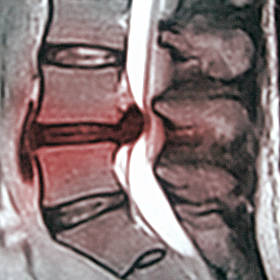At least half of herniated discs spontaneously de-herniate
Four pages on PainSci cite Zhong 2017: 1. How to Treat Sciatic Nerve Pain 2. The Complete Guide to Low Back Pain 3. The Complete Guide to Neck Pain & Cricks 4. MRI and X-Ray Often Worse than Useless for Back Pain

PainSci commentary on Zhong 2017: ?This page is one of thousands in the PainScience.com bibliography. It is not a general article: it is focused on a single scientific paper, and it may provide only just enough context for the summary to make sense. Links to other papers and more general information are provided wherever possible.
Once a spinal disc has “slipped,” it seems like it’s in a biomechanically awkward situation and can’t recover any more than a broken window can reassemble itself. And yet several studies — like Kjaer 2016, which followed dozens of patients for eight years — have suggested that herniated discs spontaneously de-herniate!
This paper (Zhong et al) is the first meta-analysis of those studies. The pooled data from eleven of them shows an extremely high overall incidence of disk resorption: a whopping 66% in patients who received conservative therapy (anything but surgery). This adds to the already large pile of evidence that back pain’s bark is usually much worse than its bite, and MRI and x-ray are almost useless for most low back pain.
More study is needed — of course, as always — because none of these studies were randomized controlled trials, and there was barely enough data for meta-analysis. However, the final number is so high that it’s safe to assume that approximately “lots” of herniations resolve on their own.
As if this wasn’t counter-intuitive enough already, the worst herniations are actually the most likely to regress (see Chiu et al). The temptation to assume the opposite is hard to resist, but “common sense” is useless in musculoskeletal medicine, a field where there seem to be no safe assumptions.
Does this data show that “conservative therapy” is the key to resorption? Unfortunately not: “conservative therapy” is vague to the point of being meaningless here. All it does mean is that these patients were treated with anything but surgery (or injections). We already suspect that resorption occurs whether people receive any treatment or not (Kjaer again), and we know that there are no clearly effective therapies for back pain at all (Cashin). The only thing we can tell from this paper is that many herniations resolve without surgery, not that therapy fixes herniations.
original abstract †Abstracts here may not perfectly match originals, for a variety of technical and practical reasons. Some abstacts are truncated for my purposes here, if they are particularly long-winded and unhelpful. I occasionally add clarifying notes. And I make some minor corrections.
BACKGROUND: Lumbar disc herniation (LDH), a common disease, is often treated conservatively, frequently resulting in spontaneous resorption of the herniated disc. The incidence of this phenomenon, however, remains unknown.
OBJECTIVE: To analyze the incidence of spontaneous resorption after conservative treatment of LDH using computed tomography and magnetic resonance imaging.
STUDY DESIGN: Meta-analysis and systematic review of cohort studies.
SETTING: The work was performed at The Suzhou Hospital of Traditional Chinese Medicine, Shanghai University of Traditional Chinese Medicine.
METHODS: We initiated a search for the period from January 1990 to December 2015 using PubMed, Embase, and the Cochrane Library. Two independent reviewers examined the relevant reports. The references from these reports were also searched for additional trials using the criteria established in the PRISMA statement.
RESULTS: Our results represent the pooled results from 11 cohort studies. The overall incidence of spontaneous resorption after LDH was 66.66% (95% CI 51% - 69%). The incidence in the United Kingdom was 82.94% (95% CI 63.77% - 102.11%). The incidence in Japan was 62.58% (95% CI 55.71% - 69.46%).
LIMITATIONS: Our study was limited because there were few sources from which to extract data, either in abstracts or published studies. There were no randomized, controlled trials that met our criteria.
CONCLUSIONS: The phenomenon of LDH reabsorption is well recognized. Because its overall incidence is now 66.66% according to our results, conservative treatment may become the first choice of treatment for LDH. More large-scale, double-blinded, randomized, controlled trials are necessary to study the phenomenon of spontaneous resorption of LDH.
related content
- “Resolution of Lumbar Disk Herniation without Surgery,” Jennifer Hong and Perry A Ball, NEJM.org.
- “Progression of lumbar disc herniations over an eight-year period in a group of adult Danes from the general population: a longitudinal MRI study using quantitative measures,” Kjaer et al, BMC Musculoskeletal Disorders, 2016.
- “Magnetic resonance imaging in follow-up assessment of sciatica,” Barzouhi et al, New England Journal of Medicine, 2013.
- “The probability of spontaneous regression of lumbar herniated disc: a systematic review,” Chiu et al, Clinical Rehabilitation, 2015.
- “Running exercise strengthens the intervertebral disc,” Belavý et al, Scientific Reports, 2017.
- “Systematic Literature Review of Imaging Features of Spinal Degeneration in Asymptomatic Populations,” Brinjikji et al, AJNR Am J Neuroradiol, 2015.
- “MRI Findings of Disc Degeneration are More Prevalent in Adults with Low Back Pain than in Asymptomatic Controls: A Systematic Review and Meta-Analysis,” Brinjikji et al, AJNR Am J Neuroradiol, 2015.
This page is part of the PainScience BIBLIOGRAPHY, which contains plain language summaries of thousands of scientific papers & others sources. It’s like a highly specialized blog. A few highlights:
- The Problematic Nature of Fibromyalgia Diagnosis in the Community. Srinivasan 2019 ACR Open Rheumatol.
- Fibromyalgia diagnosis and biased assessment: Sex, prevalence and bias. Wolfe 2018 PLoS One.
- Restoring trust in menopause management: menopause hormone therapy is not a panacea, and physical activity remains a critical intervention. Tulloh 2025 Br J Sports Med.
- Common interventional procedures for chronic non-cancer spine pain: a systematic review and network meta-analysis of randomised trials. Wang 2025 BMJ.
- Gabapentinoids and Risk of Hip Fracture. Leung 2024 JAMA Netw Open.